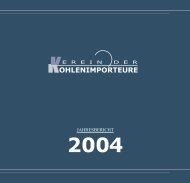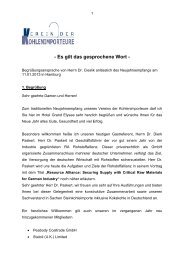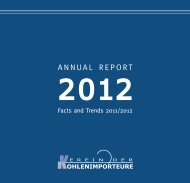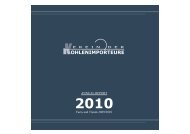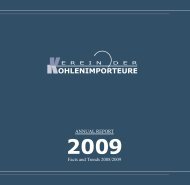Annual Report 2010 - Verein der Kohlenimporteure eV
Annual Report 2010 - Verein der Kohlenimporteure eV
Annual Report 2010 - Verein der Kohlenimporteure eV
You also want an ePaper? Increase the reach of your titles
YUMPU automatically turns print PDFs into web optimized ePapers that Google loves.
producers and consumers. The contract price for hard<br />
coking coal agreed between Australian suppliers and<br />
the Japanese steel industry for the current Japanese<br />
fiscal year (April/March) serves as a benchmark.<br />
However, this practice has changed over the last year or<br />
so. The large coking coal producers have moved away<br />
from the previous system of annual contract prices<br />
to a quarterly price structure. At the same time, first<br />
attempts are being made to establish coking coal price<br />
indices. As a result, spot market elements are having<br />
a greater impact on pricing. American coking coal<br />
producers continue to offer annual prices, while one<br />
other producer wants to switch to monthly prices.<br />
600<br />
500<br />
400<br />
300<br />
200<br />
100<br />
0<br />
1/10<br />
2<br />
<br />
(12-12.5 % Ash, spot)<br />
3<br />
4<br />
5<br />
12-12.5 % Ash, spot<br />
Figure 13 Source: China Coal <strong>Report</strong> and other<br />
6<br />
7<br />
8<br />
9<br />
10<br />
11<br />
12<br />
1/11<br />
2<br />
3<br />
4<br />
Coke prices ex-China still remain very high. ARA<br />
prices in <strong>2010</strong> were substantially lower, but have<br />
however been rising in recent months.<br />
<br />
The Baltic Dry Index dropped steadily last year and<br />
<br />
<br />
before October <strong>2010</strong>.<br />
The main reason is fleet overcapacity. This has since<br />
increased even more to the point where even with robust<br />
economic growth, the resulting demand cannot keep<br />
pace with bulk volumes. The collapse is particularly<br />
important for Capesize vessels.<br />
100<br />
90<br />
80<br />
70<br />
60<br />
50<br />
40<br />
30<br />
20<br />
10<br />
0<br />
Freight Rates (capesize) of Hard Coal<br />
(spot) – ARA Ports<br />
USD/t<br />
Richards Bay<br />
Newcastle<br />
Puerto Bolivar<br />
Figure 14 Source: Frachtcontor Junge<br />
Jan<br />
July<br />
Jan<br />
July<br />
Jan<br />
July<br />
Jan<br />
July<br />
Jan<br />
July<br />
Jan<br />
July<br />
Jan<br />
July<br />
Jan<br />
July<br />
Jan<br />
July<br />
Jan<br />
The fleet capacity increase in <strong>2010</strong> was about 16%,<br />
while the volume of bulk goods shipped globally,<br />
according to estimates, only increased by about 10%.<br />
This created a wide gap between supply and demand.<br />
Demurrage situations in Australia, China and Brazil<br />
reduced available capacities, but could not stop the rates<br />
crashing. It is all the more remarkable that despite the<br />
weak market and the unchanged high number of or<strong>der</strong>s<br />
for new builds, more ships are being or<strong>der</strong>ed. In <strong>2010</strong>,<br />
138 Capesize, 59 Post-Panamax (95,000 DWT) and 356<br />
Panamax vessels were or<strong>der</strong>ed. In January 2011 alone,<br />
13 Capesize, 5 Post-Panamax and 13 Panamax vessels<br />
were or<strong>der</strong>ed. Against this background, freight rates<br />
might remain very low, within the range 9-12 US$/t for<br />
the benchmark route South Africa – ARA.<br />
25



